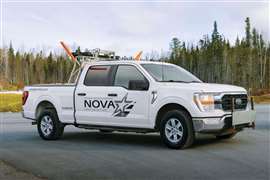Ignacio Simón at Linden Comansa talks about winch development in recent years
09 January 2012

Ignacio Simón, system designer at Spanish tower crane manufacturer Linden Comansa, talks to Euan Youdale about developments in winch systems over recent years
In November Linden Comansa announced the launch of what it describes as the biggest flat top tower crane series in the world. The LC3000 series includes two models: the 30 LC 1100 and 30 LC 1450, each with three versions, offering 32, 48 and 64 tonne lifting capacities.
Many of the series' innovations remain confidential, including the winch system, which offers a 200 kW hoist. However, the story of the winch's design is an insightful one and a tale littered with challenges.
Ignacio Simón, system designer at Linden Comansa, explains that increasing the winch's power is not always the best solution. "We began to think about the way things had been done in the past. We found we should look for a solution to keep the same power but to try and increase the maximum speed of the crane; that's quite important for the tallest applications.
"Of course you can get this evolution by increasing power but this will force you to increase the capacity of the power supply and you will have more expensive devices, such as inverters and so on, and increased energy consumption."
The process involved surveying winch suppliers, not only in the crane sector but other applications, including the automotive industry, to find which trends were being followed and what improvements had been made. A number of useful conclusions emerged, says Simón.
"In the automotive industry we found energy recovery, with frequency converters, gear boxes, etcetera, was an area they were moving into, while other manufacturers were interested in direct drive from the motors. We looked at all these things to see if we should go for them or not."
The process ended in a report, highlighting a number of areas, including improvements to motor energy efficiency, as well as increasing their working range and speed. Following that was the launch of the company's Effi-plus system last year for winches above 24 kW and up to 110 kW. "When you are working with very high speeds you have to think of how to properly decelerate the load; that's the kind of thing we did with Effi-plus. We have increased maximum speeds on the whole range of winches, but we found that it was important to take care of increased energy in the system, not only in the load but in the motor," explains Simón. The LC3000 will incorporate Effi-plus technology, adds Simón, but there will be a new approach too.
Common requirements from customers included durability, modular components transferable across products and the ability to easily access the winch system for maintenance. Easily available spare parts and safety were also key issues.
Linden Comansa devised a pair of formulas, representing the cycle time of the crane - the isolated productivity of the hoist, which allows the manufacturer to compare the efficiency of cranes. The first formula, see Figure 1, represents a crane being used on a construction site, where items are being hoisted to a considerable height before the hook is lowered back down with no load. The second, see Figure 2, refers to a setting in which the crane picks, slews and then delivers the load all at the same height, as is often found in industrial applications.
"We compared our own systems with the new ones. We found with the Effi-plus system we made up to a 30% increase in productivity. This does not mean the speed increases just 30%, it increases more but we decided to give a more realistic value. For example, you say that the load speed has increased by twice the amount, but this does not mean the crane will be 100% more efficient."
In turn, by looking at the Critical Constraints chart drawn up by Linden Comansa, it can be decided which is the most suitable crane required for a customer's application, see Figure 3. Where, for instance, the average height of the lift is medium to high, but the weight of load is relatively low, possibly 1 tonne, there is a requirement for maximum speed but not such high power.
"Capacity is a very important thing. The crane tonnage will be defined by the maximum tonnage you have to hoist, even if it only needs to be lifted very occasionally. For maximum productivity of the site, you may consider breaking the maximum load into two or three sections, then you do not have to choose a more powerful crane, which is usually slower."
In the last Critical Constraints quadrant, power is required but not maximum speed, because the height of the lift is not that great, perhaps 30 metres. This means a 100 m/min winch might be enough, says Simón. "This is an important thing. We have to take a rational approach to decide the proper tonnage of a crane for our customers."
Simón adds that Linden Comansa is reaching the limits of the crane winch concept. "Once you have a 200 to 300 m/min winching speed, you should not go much further than that. Future improvements will not just come from power and speed but maintainability, and other areas, because we must consider the winch as part of a system and take a systematic approach," he adds.
"On the LC3000, 200 kW is a very high power and we are moving towards a region in tower cranes that has not been reviewed by the industry for a long time. We are approaching this in a different way and it will not only include a classic frequency inverter control but also some new things, small pieces of technology that will make a difference."






